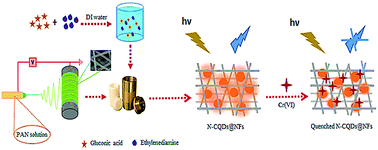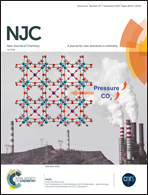Preparation of polyacrylonitrile nanofibers decorated by N-doped carbon quantum dots: application as a fluorescence probe for determination of Cr(vi)
Abstract
This study presents a new method to synthesize a fluorescence probe using an N-doped carbon quantum dot decorated polyacrylonitrile nanofiber (N-CQD@NF) nanocomposite. For this purpose, a combination of the electrospinning technique and a facile hydrothermal method was applied. Gluconic acid and ethylenediamine which are sources for carbon and nitrogen respectively, were used for synthesizing N-CQDs. Characterization of the synthesized fluorescence probe was done using photoluminescence spectroscopy, scanning electron microscopy (SEM), X-ray diffraction (XRD), transmission electron microscopy (TEM), X-ray photoelectron spectroscopy (XPS), and Fourier-transform infrared spectroscopy (FT-IR). As Cr(VI) quenches the fluorescence intensity of N-CQD@NF, it can assist in identifying Cr(VI) in environmental samples. Fluorescence probe emission quenching due to a Cr(VI) concentration was observed. It confirmed that Cr(VI) can be detected via employing the fluorescence probe. Using this method and in the optimal conditions, Cr(VI) was determined in a concentration range of 0.15–160.0 μmol L−1 with a detection limit of 0.05 μmol L−1. The selectivity of the method for Cr(VI) is high in comparison to other kinds of ions. As a result, it can be concluded that the nanocomposite is an applicable sensitive probe in determination of Cr(VI) in tap and spring water samples.



 Please wait while we load your content...
Please wait while we load your content...